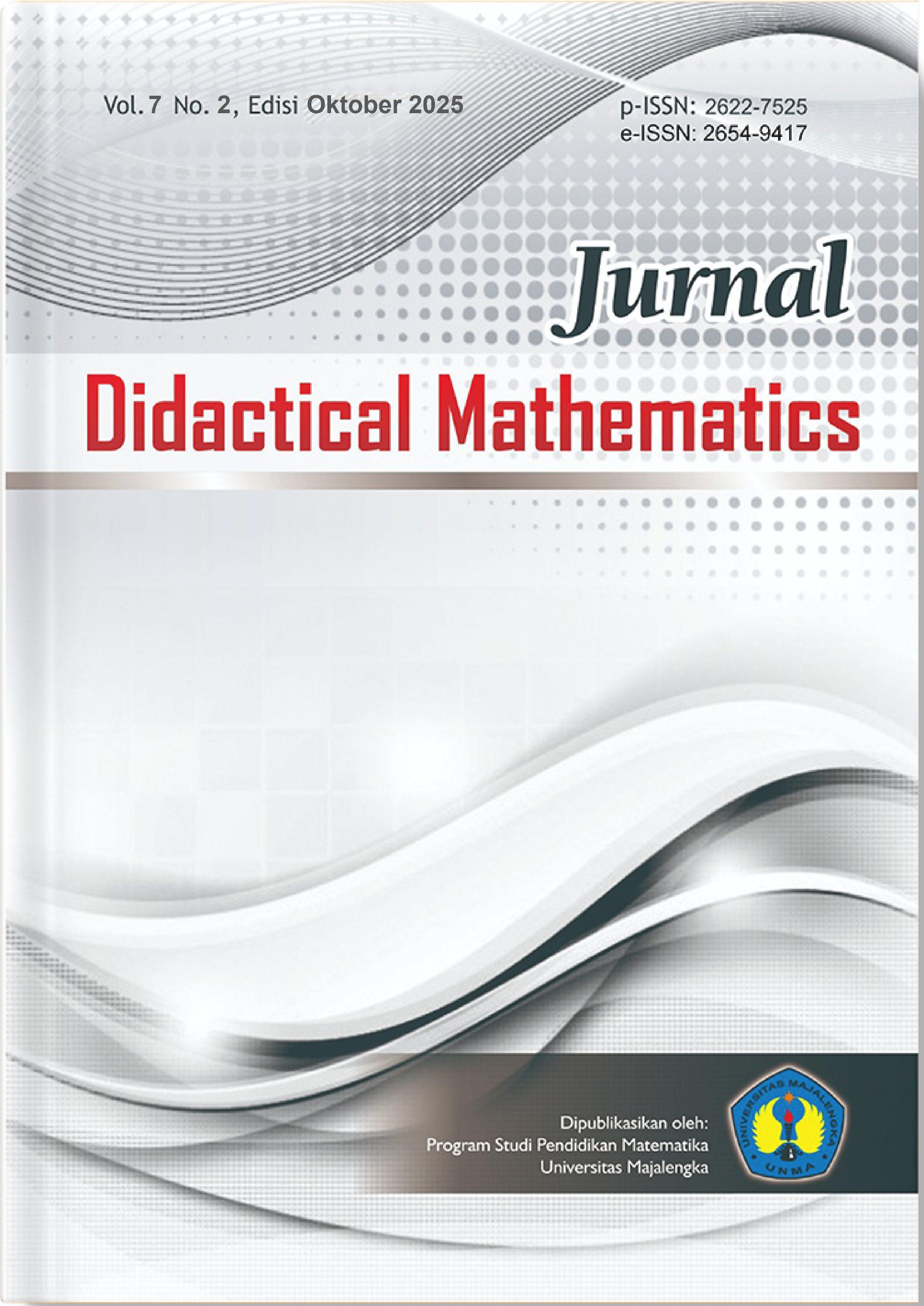Integrasi Simulasi Virtual Reality (VR) Imersif Terhadap Pemahaman Konsep Pengukuran Siswa Sekolah Dasar
DOI:
https://doi.org/10.31949/dm.v7i2.13540Abstract
This study aims to examine the effect of integrating immersive Virtual Reality (VR) simulations on elementary school students' understanding of measurement concepts. The primary issue addressed is the low level of student comprehension regarding abstract measurement concepts, which are often difficult to visualize through conventional teaching methods. This research employed a quasi-experimental method with a nonequivalent control group design. The sample consisted of two fourth-grade classes at SD Negeri 1 Selaawi: the experimental class received VR-based learning, while the control class underwent traditional instruction. The research instruments included a conceptual understanding test, a student response questionnaire, and classroom observation. Data analysis was conducted using normality tests, the Mann-Whitney U test, and descriptive statistics. The results revealed a significant improvement in students' understanding of measurement concepts in the experimental class compared to the control group. The average posttest score in the experimental class increased from 70.58 to 75.24, while the control class rose from 72.28 to 73.71. The Mann-Whitney U test showed a significance value of 0.009 for the posttest, indicating a statistically significant difference between the two groups. Moreover, the questionnaire results indicated positive student responses to VR-based learning, especially in terms of visualization and conceptual comprehension. The use of VR simulations proved effective in providing a more interactive, contextual, and enjoyable learning experience. Therefore, the integration of VR technology is recommended as an innovative strategy in mathematics instruction at the elementary level, particularly to enhance students’ conceptual understanding of measurement.
Keywords:
Virtual Reality; measurement; conceptual understandingDownloads
References
Abadi, M. A. S., & Amir, M. F. (2022). Analysis of the Elementary School Students Difficulties of in Solving Perimeter and Area Problems. JIPM (Jurnal Ilmiah Pendidikan Matematika), 10(2), 396. https://doi.org/10.25273/jipm.v10i2.11053
Aishah Ahad, N., Sin Yin, T., Rahman Othman, A., & Rohani Yaacob, C. (2011). Sensitivity of Normality Tests to Non-normal Data (Kepekaan Ujian Kenormalan Terhadap Data Tidak Normal). In Sains Malaysiana (Vol. 40, Issue 6).
Begum, Dr. S. (2024). Virtual Reality In Education: Transforming Learning Environments. Educational Administration: Theory and Practice, 8967–8973. https://doi.org/10.53555/kuey.v30i5.4491
Chen, C. , L. H. , & L. H. (2020). Effects of Virtual Reality Learning on Students’ Spatial Skills and Engagement: A Meta-Analysis. Computers & Education, 145, 103720. https://doi.org/https://doi.org/10.1016/j.compedu.2020.103720
Jiang, J., & Fryer, L. K. (2024). The effect of virtual reality learning on students’ motivation: A scoping review. Journal of Computer Assisted Learning, 40(1), 360–373. https://doi.org/10.1111/jcal.12885
Kementerian Pendidikan dan Kebudayaan. (2018). Peraturan Menteri Pendidikan dan Kebudayaan Republik Indonesia Nomor 37 Tahun 2018 tentang perubahan atas Peraturan Menteri Pendidikan dan Kebudayaan Nomor 24 Tahun 2016 tentang Kompetensi Inti dan Kompetensi Dasar pelajaran pada kurikulum 2013 pada pendidikan dasar dan pendidikan menengah. https://jdih.kemdikbud.go.id. https://jdih.kemdikbud.go.id
Lin, X. P., Li, B. Bin, Yao, Z. N., Yang, Z., & Zhang, M. (2024). The impact of virtual reality on student engagement in the classroom–a critical review of the literature. Frontiers in Psychology, 15, 01–08. https://doi.org/10.3389/fpsyg.2024.1360574
Makransky, G., & Petersen, G. B. (2021). The Cognitive Affective Model of Immersive Learning (CAMIL): a Theoretical Research-Based Model of Learning in Immersive Virtual Reality. Educational Psychology Review, 33(3), 937–958. https://doi.org/10.1007/s10648-020-09586-2
Nasir, M. , & R. D. (2020). Media Pembelajaran Berbasis Virtual Reality untuk Konsep Bangun Ruang. Jurnal Teknologi Pendidikan Indonesia, 12(2), 45–55. https://doi.org/https://doi.org/10.21009/jtpi.v12i2.12345
Naufal Azmi, M., Mansur, H., & Hadi Utama, A. (2024). Potensi Pemanfaatan Virtual Reality Sebagai Media Pembelajaran Di Era Digital. Jurnal Dimensi Pendidikan Dan Pembelajaran, 12(1), 211–226. http://journal.umpo.ac.id/index.php/dimensi/index
Silalahi, Y. G., Ariyanti, E., Sihombing, M., Lubis, A., & Yus, A. (2024). Analysis of Difficulties in Learning Mathematics Material for Measuring Units of Weight in Class III Elementary School Students. Budapest International Research and Critics Institute-Journal (BIRCI-Journal), 7(2), 425–431. https://doi.org/10.33258/birci.v7i2.7897
Styadi, A., & Istiyowti, L. S. (2025). Implementasi Virtual Reality dalam Kegiatan Pembelajaran di Sekolah Dasar. Edukasi Elita : Jurnal Inovasi Pendidikan, 2(1), 21–27. https://doi.org/10.62383/edukasi.v2i1.889
Sugiyono. (2017). Metode Penelitian Kombinasi (Mixed Methods) (Sutopo, Ed.; 4th ed.). Alfabeta.
Susanti Telaumbanua, M., Berkat Tabah Hulu, D., Surya Astuti Zebua, N., Zalukhu, A., Naibaho, T., & Mayasari Simanjuntak, R. (2023). Evaluasi dan Penilaian pada Pembelajaran Matematika. Journal on Education, 06(01), 4781–4792.
Tsaaqib, A., Buchori, A., & Endahwuri, D. (2022). Efektivitas Penggunaan Media Pembelajaran Virtual Reality (VR) Pada Materi Trigonometri Terhadap Motivasi Dan Hasil Belajar Matematika Siswa SMA. Jurnal Ilmiah Pendidikan Matematika, 7(1), 11–19. https://doi.org/DOI: 10.26877/jipmat.v7i1.9950
Wulan, S., Hasanah Pendidikan Guru Sekolah Dasar, N., & Kusuma Negara Jakarta, S. (2020). Meningkatkan Pemahaman Konsep Matematika Materi Pengukuran Satuan Berat melalui Metode Drill pada Siswa Sekolah Dasar. Prosiding Seminar Nasional Pendidikan STKIP Kusuma Negara II, 225–234.
Zulfikri, A. (2023). Dampak Implementasi Teknologi Virtual Reality dalam Pembelajaran Matematika pada Siswa Sekolah Dasar di Kabupaten Sukabumi. Jurnal Pendidikan West Science, 01(06), 258–265.
Published
How to Cite
Issue
Section
License
Copyright (c) 2025 Didactical Mathematics

This work is licensed under a Creative Commons Attribution-ShareAlike 4.0 International License.









